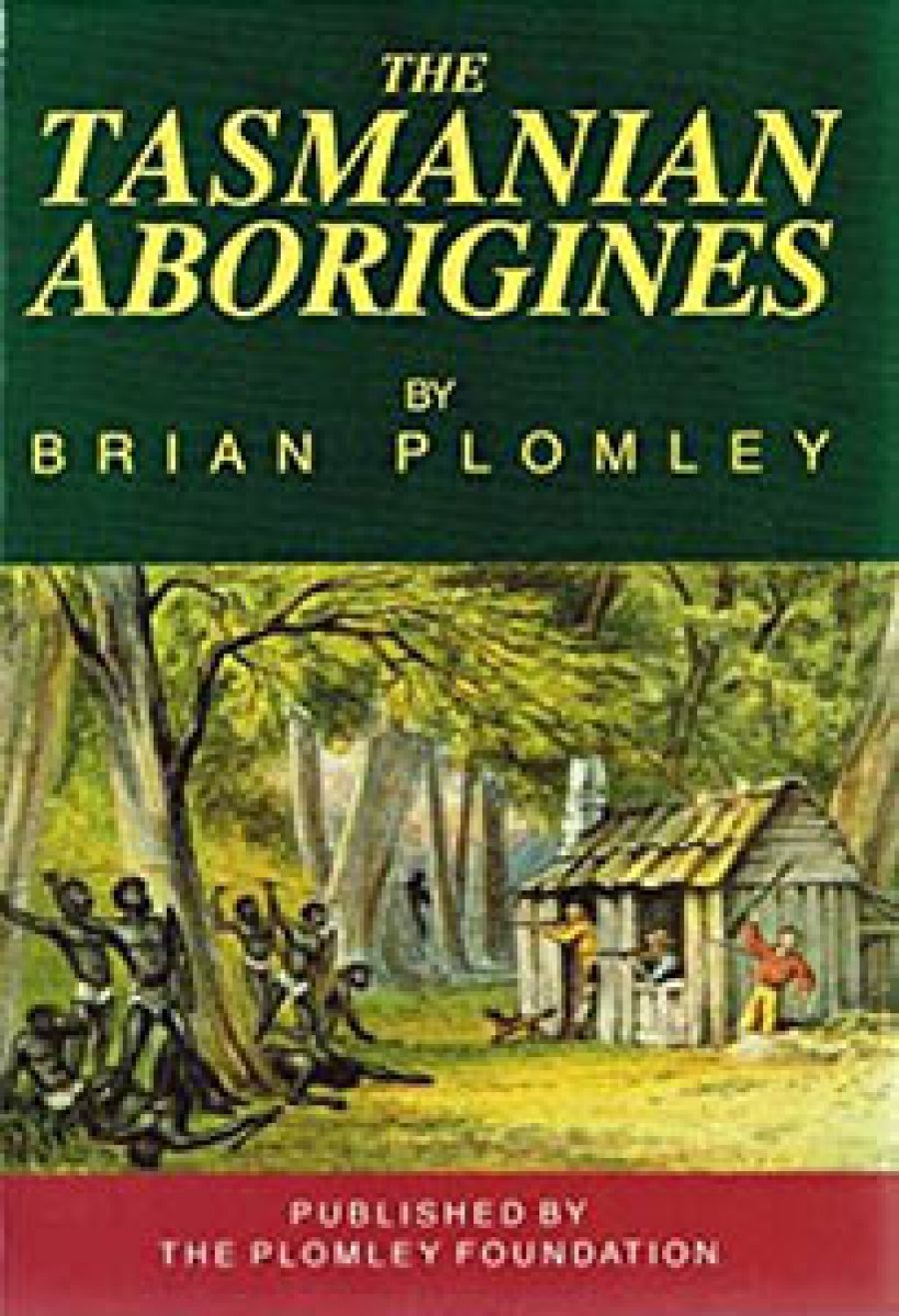
- Free Article: No
- Contents Category: Indigenous Studies
- Review Article: Yes
- Article Title: Too soon out of date
- Online Only: No
- Custom Highlight Text:
This is a sad, short book – sad in more ways than one. It is the last work of this century’s greatest authority on the Tasmanian Aborigines. It is the distillation of sixty years of detailed and diverse work. And it is deeply flawed.
Brian Plomley, who died earlier this year, was best known for his doorstop volumes on the original Tasmanians (The Friendly Mission and Weep in Silence). For these we owe Plomley a great debt. He dedicated decades of his life to getting inside the mind of G.A. Robinson, the so-called Conciliator of Tasmania’s last tribal Aborigines. His insights into that man and his era, and the thoroughness of his work on the thinly-spread evidence of pre-European Aboriginal culture in Tasmania, are unique. They would lead us to expect the present slim volume to be a rich distillation. Instead the undoubted riches are contaminated by errors both of fact and judgement.
- Book 1 Title: The Tasmanian Aborigines
- Book 1 Biblio: The Plomley Foundation, $10.95 pb
The tone is set from the second paragraph, which boldly states that ‘the Tasmanian full-bloods who occupied Tasmania when European settlement began in 1803 are now an extinct people’. A man of Plomley’s intelligence must have known that this view – a reiteration of that in his 1966 work, Friendly Mission – is now totally repugnant to many, not least Tasmania’s Aboriginal community. The repeated use of terms such as ‘half-caste’, ‘mixed blood’ and talk of ‘diluting the Aboriginal gene pool’ have about them the whiff of intellectual genocide. It looks to be part of what Cassandra Pybus calls the ‘determination to define the original Tasmanians as not being’ despite the survival of a disparate Tasmanian Aboriginal population.
Plomley’s unfashionable views are derived from his 1930s and 1940s background in genetics and biology. From these he developed a rigidly prescriptive genetic definition of Aboriginality from which he never shifted, regardless of whatever legal and social definitions of Aboriginality supervened.
Unfortunately his inflexibility goes beyond this definition. The book has numerous other outdated scientific references and anachronisms. Some of these are simply irritating, as when he consistently refers to possums as ‘opossum’ and quolls as ‘tiger cats’, or when he refers to ‘several species of bandicoot’ when there are only two in Tasmania. These seem minor flaws, but they betray Plomley’s disregard for developments in areas that don’t vitally concern him.
More jarring is Plomley’s refusal to heed his own advice. ‘It seems strange that while we have no difficulty in believing that other individuals think differently from ourselves … we usually fail to accept the idea that groups of people are different except in a way which denigrates them and puts our status above theirs.’ This despite the fact that Plomley himself characterises Aboriginal ceremonial life as ‘poorly developed’ and the people themselves as ‘deprived’ by isolation.
At other points, dubious judgement seems based on thin evidence, as when supposed low populations are thought to result from ‘some form of birth control or infanticide’. There is evidence for neither, and the jury is still out on whether population levels were as low as some (including Plomley) have assumed.
He is also plainly out of step when it comes to dating. His estimate of 23,000 years+ for Aboriginal occupation of Tasmania is wildly conservative. Recent work by Professor Jim Allen in the Maxwell River valley in Tasmania’s south-wet has found materials from at least 35,000 years ago, and it seems likely that continuing work will stretch that date considerably further.
It is hard to believe that Plomley was unaware of such work. Rather it seems that the published date of this book merely indicates its issue date, not the date of the research done for it. Other internal indications are that there has been little updating of work since the 1970s (when Plomley published a similar work, unacknowledged in this book).
That is not to belittle Plomley’s recent work. For instance on the subject of clashes between Aborigine and settler, he is quite acute, as the summary of those clashes indicates. Plomley is at his best when he gets inside the mind of nineteenth-century settlers and examines the influence their thinking must have on Aboriginal people: ‘The philosopher might hold the savage to be noble and the Christian preach the universal brotherhood of mankind, but the colonist would be motivated solely by his own interests.’ It is a sad but succinct summary of the facts.
But Plomley’s interest in recent issues is selective. Any expectation that this 1993 work would survey the latest information in the field will be disappointed. Though at times it tantalises with its almost vivid reconstruction of pre-European Aboriginal life, it generally fails to give the neat, up-to-date summary that it promised.
Unfortunately there is no other popular work that will stand in its place. Neither Tasmania’s Aboriginal community nor its scientific community has come up with such a work. If the upshot of this book is that others are given impetus to present the full story in popular form, then its publication will not be a waste. Otherwise this book will stand as a sadly out-of-touch final word from a gifted and diligent scholar.


Comments powered by CComment